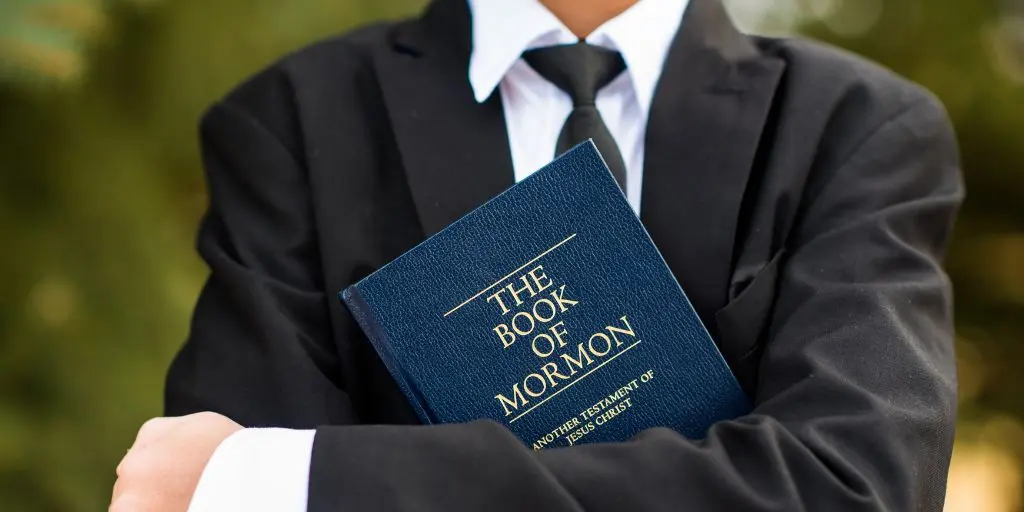The Bible and the Book of Mormon

According to Joseph Smith, the Book of Mormon is “the most correct of any book on earth, and the keystone of our religion, and a man would get nearer to God by abiding by its precepts, than any other book.”[1] This book allegedly provides an abridged narrative of God’s interactions with the indigenous inhabitants of the American continent from 2247 B.C. to A.D. 421. It was supposedly first etched on gold plates by ancient prophets in the language of “Reformed Egyptian,” placed in a stone casket, and then buried in New York’s Hill Cumorah. It is described as God’s uncorrupted revelation to humanity, the “fullness of the everlasting gospel,” and “another Testament of Jesus Christ.” Smith is said to have translated the Book of Mormon from the gold plates using a “seer stone.”
David Whitmer, one of Smith’s companions, discusses the translation process for the Book of Mormon:
Joseph Smith would put the seer stone into a hat, and put his face in the hat, drawing it closely around his face to exclude the light; and in the darkness the spiritual light would shine. A piece of something resembling parchment would appear, and on that appeared the writing. One character at a time would appear, and under it was the interpretation in English. Brother Joseph would read off the English to Oliver Cowdery, who was his principal scribe, and when it was written down and repeated to Brother Joseph to see if it was correct, then it would disappear, and another character with the interpretation would appear. Thus the Book of Mormon was translated by the gift and power of God, and not by any power of man.[2]
Following the translation of the Book of Mormon, Smith claimed to have heard a voice from a bright light above him say, “These plates have been revealed by the power of God, and they have been translated by the power of God. The translation of them which you have seen is correct, and I command you to bear record of what you now see and hear.”[3] Given this precise and exact method, which includes individual characters and particular words, as well as a purported direct confirmation from God, it appears that the Book of Mormon has no space for human error.
Mormons believe the Bible foretells the Book of Mormon. Indeed, they believe the two sticks referenced in Ezekiel 37:16-17 represent the Bible and the Book of Mormon. This appears to add authority to the Book of Mormon.
Mormons frequently use James 1:5—“If any of you lacks wisdom, he should ask God, who gives generously to all without finding fault, and it will be given to him”—to encourage people on their doorstep to pray about the Book of Mormon and ask God whether it is true. Potential converts are assured that God will show them the text is authentic.
Thousands of Changes
An examination of the evidence reveals that the Book of Mormon is a manmade book and should not be trusted. To begin with, we observe that thousands of changes have been introduced to the Book of Mormon since its original publication. According to historical analyses, more than 3,913 alterations have occurred between the original edition of the Book of Mormon published in 1830 and those produced and issued through the mid-1970s. The 1981 edition had between one and two hundred additional word changes.[4]
Though many of the changes concern spelling and grammar, some are substantial. For example, in 1 Nephi 11:21, the phrase “Behold the Lamb of God, yea, even the eternal Father” is changed to “Behold the Lamb of God, yea even the son of the eternal Father.”
The problem is that the Mormon story of how Smith translated the Book of Mormon excludes the possibility of errors, including misspellings and grammar. Smith used a “seer stone” to see one character at a time and read it to Oliver Cowdery, who would repeat the character to confirm accuracy before that character disappeared and another appeared. As a result, every letter and word were reportedly delivered by the power of God.[5]
It is, of course, unwise—indeed, it is madness—to base one’s salvation on a book that has undergone over 4,000 revisions since its first publication.
Numerous Plagiarisms
Aside from the thousands of alterations made to the text of the Book of Mormon, the text is further undercut by the numerous plagiarisms from the King James Version of the Bible. The Book of Mormon contains around 27,000 words directly from the King James Version of the Bible. Whole chapters have been lifted right out of the book of Isaiah.
Even the italicized words from the KJV were included in the Book of Mormon. This is relevant because, as noted in the preface of the KJV, these words were not in the original languages but were added by the KJV translators to provide clarity. If the Book of Mormon was first penned between 600 B.C. and A.D. 421, as claimed, how could it contain such extensive quotations from the A.D. 1611 KJV, using archaic King James English, and including the translator’s “inserted clarifying words”[6]
There have also been charges over the years that Smith may have borrowed from other available materials of his day. Some suspect he plagiarized from Solomon Spaulding, a retired preacher who penned two fictional accounts of America’s early inhabitants. The problem is that the book from which the Book of Mormon was purportedly plagiarized is missing. As Ruth Tucker explains in her book Another Gospel, “This missing volume, known as Manuscript Found, was, as the theory goes, left in a print shop where it was stolen by Sidney Rigdon, a close associate of Smith in the early days of Mormonism. Spaulding died in 1816, fourteen years before the Book of Mormon was published, but his stories had not been forgotten.”[7] He purportedly told patrons in his bar stories about Nephi and Lehi, which subsequently made their way into the Book of Mormon. Mormons have made significant efforts to discredit all of this. Without more proof, the question remains open to debate.
Others have speculated that Smith may have borrowed from Ethan Smith’s book View of the Hebrews, which claimed that American Indians had Hebraic ancestry. Fawn Brodie, a critic, points out that “it may never be proved that Joseph [Smith] saw View of the Hebrews before writing the Book of Mormon, but the striking parallelisms between the books hardly leave a case for mere coincidence.”[8] Taken together, the preponderance of evidence suggests that Joseph Smith plagiarized significantly from a variety of sources. As a result, we surmise that the book is manmade and is hence untrustworthy.
No Archeological Support
According to Mormon scriptures, the Nephite and Lamanite nations had massive populations in enormous, fortified cities. They purportedly fought large-scale wars with one another for hundreds of years, culminating in a conflict that killed hundreds of thousands of people in A.D. 385 near Hill Cumorah in present-day New York State (see Mormon 6:9-15). One would expect archeological evidence to support the claim that all this occurred. However, there is no evidence that any of it ever happened. While there is extensive archeological evidence to support the individuals and places recorded in the Bible, such evidence is lacking for the Book of Mormon.
Non-Mormon archeologists have studied Mesoamerica so thoroughly that if what is in the Book of Mormon is genuine, one of them would have presented evidence in support of it by now. But that has not occurred. The evidence of non-Mormon archeologists is utterly absent.
Archeological institutions have unequivocally rejected Mormon claims. The National Museum of Natural History, Smithsonian Institution, in Washington, D.C., stated that “Smithsonian archeologists see no direct connection between the archeology of the New World and the subject matter of the book [of Mormon].”[9]
Similarly, the Bureau of American Ethnology stated, “There is no evidence whatever of any migration from Israel to America, and likewise no evidence that pre-Colombian Indians had any knowledge of Christianity or the Bible.”[10] In a letter dated February 4, 1982, the National Geographic Society declared that “although many Mormon sources claim that the Book of Mormon has been substantiated by archeological findings, this claim has not been verified scientifically.”[11]
In an article published in Dialogue: A Journal of Mormon Thought, Dee Green, Assistant Professor of Anthropology at Weber State College, stated, “The first myth we need to eliminate is that Book of Mormon archeology exists…. If one is to study Book of Mormon archeology, then one must have a corpus of data with which to deal. We do not…. No Book of Mormon location is known with reference to modern topography. Biblical archeology can be studied because we do know where Jerusalem and Jericho were and are, but we do not know where Zarahemla and Bountiful (nor any other location for that matter) were or are.”[12]
Many Mormon scholars try hard to find Book of Mormon lands in Central America. However, these scholars disagree amongst themselves about where in Central America the Book of Mormon lands may be (some say the Costa Rica area, others say the Yucatan Peninsula, and others say the Tehuantepec area). The fact remains that there is virtually no solid archeological support for any of this.
If there were large-scale wars, culminating in an upheaval in which hundreds of thousands of people were slaughtered in A.D. 385 near Hill Cumorah in present-day New York State, wouldn’t non-Mormon archeologists have found some evidence that such a conflict occurred? Such evidence seems ever absent.
The Bible Does Not Prophesy the Book of Mormon
The Bible does not prophesy about the Book of Mormon, as Mormons claim. Mormons are practicing fanciful eisegesis (reading a meaning into the text of Scripture) instead of exegesis (drawing the meaning from the text of Scripture) in claiming that the Bible prophesies the Book of Mormon. Let’s consider one of their primary prooftexts, Ezekiel 37:16-17.
In this passage, we read, “Son of man, take a stick and write on it, ‘For Judah, and the people of Israel associated with him’; then take another stick and write on it, ‘For Joseph (the stick of Ephraim) and all the house of Israel associated with him.’ And join them one to another into one stick, that they may become one in your hand.” Mormons think this passage points to the Bible and the Book of Mormon. They believe the sticks mentioned in this passage are pieces of wood around which a papyrus scroll was wrapped. When this directive was given in Ezekiel 37:16-17, it amounted to mandating the keeping of two books or records. One of the sticks (Judah) is purportedly alluding to the Bible, while the other (Joseph) allegedly refers to the Book of Mormon.
Contrary to this assertion, the context indicates what the two “sticks” are. The Bible says in Ezekiel 37:22, “I will make them one nation in the land, on the mountains of Israel. And one king shall be king over them all, and they shall be no longer two nations, and no longer divided into two kingdoms.” Instead of two books, the sticks represent two kingdoms.
The backdrop is that following Solomon’s death, Israel was divided into two minor kingdoms (931 BC). The Southern Kingdom was Judah, and the Northern Kingdom was Israel (or Ephraim). Assyria captured Israel in 722 B.C., while Babylon exiled Judah in 605, 597, and 586 B.C. The split between the kingdoms, however, would not continue forever. The joining of the “sticks” represents God’s restoration of His people, the children of Israel, into a united nation again (Ezekiel 37:18-28). Given this, it is evident that the Bible does not prophesy about the Book of Mormon.
Contradictions with Mormon Doctrine
The Book of Mormon goes against modern Mormon beliefs. Indeed, the Book of Mormon, the “keystone” of the Mormon faith, contains very little about “Mormonism” as the Mormon church teaches it today. Among other things, the Book of Mormon has no mention of…
(1) Mormon church organization;
(2) the Aaronic priesthood;
(3) the Melchizedek priesthood;
(4) the “plurality of Gods” doctrine;
(5) the “God is an exalted man” doctrine;
(6) the doctrine that men may become Gods;
(7) the doctrine of three degrees of glory, or three kingdoms;
(8) the “plurality of wives” doctrine;
(9) the “Celestial Marriage” doctrine with all the elaborate temple ceremonies and oaths;
(10) baptism for the dead;
(11) the “word of wisdom” doctrine;
(12) the doctrine of preexistence; and
(13) the doctrine of eternal progression.
Given that many of Mormonism’s principal doctrines are absent from the Book of Mormon, how can it be argued that it contains the “fullness of the everlasting gospel”? This simply does not make good sense.
Contains Other Doctrines Modern Mormons Reject
Aside from the fact that a number of crucial Mormon doctrines are not found in the Book of Mormon, the Book of Mormon also contains doctrines not embraced by modern Mormons. For example:
• Instead of teaching that there are many gods, the Book of Mormon teaches that there is only one God (Mosiah 15:1-5; Alma 11:28,29; 2 Nephi 31:21);
• Instead of teaching that people evolve to godhood, the Book of Mormon teaches that God is unchanging (Mormon 9:9,19; Moroni 8:18; Alma 41:8; 3 Nephi 24:6);
• Instead of teaching that God is a physical exalted man, the Book of Mormon teaches that God is a spirit (Alma 18:24-28; 22:9-11);
• Though current Mormon leaders do not teach polygamy, both Joseph Smith and Brigham Young (the two greatest leaders in Mormon history) taught polygamy, even though the Book of Mormon condemned the practice (Jacob 1:15; 2:23,24,27,31; 3:5; Mosiah 11:2,4; Ether 10:5,7).
Given such facts, are we to conclude that the Book of Mormon is incorrect?
Or is the current Mormon leadership mistaken?
Which one is it?
No Need to “Pray” About the Book of Mormon
People should not pray about whether the Book of Mormon is true. James 1:5 reads, “If any of you lacks wisdom, he should ask God, who gives generously to all without finding fault, and it will be given to him.” Earlier I warned that Mormons often appeal to this verse in asking people to pray about the Book of Mormon to see if it is true (Moroni 10:4-5).
However, the Mormon interpretation jerks this verse out of its context. The meaning of James 1:5 is connected to the preceding verses, which speak about the purpose of trials (verses 2-4). James anticipates that some of his readers will say they cannot discover any divine purpose in their trials. In that case, they are to ask God for wisdom.
Furthermore, even if James is not referring to gaining wisdom about the purpose of trials but is rather talking about wisdom in general, God’s “wisdom” on a matter never contradicts what He has recorded in Scripture. For this reason, one need not pray about matters on which God has already given us His verdict. One does not need to pray about whether to commit murder, commit adultery, commit incest, terrorize a playground, and the like, for God’s mind on such issues is clear from Scripture. One does not need to pray about whether to worship another god because the true God has already said it is wrong (Exodus 20:3). One does not need to pray about whether to participate in spiritism because God has already said it is wrong (Deuteronomy 18:9f.). Likewise, we do not need to pray about the Book of Mormon because God has already warned us against any “revelations” that contradict the Word of God (Galatians 1:6-8; 1 John 4:1; 2 Corinthians 11:4).
When asked to pray about the Book of Mormon, I always ask: “Which Book of Mormon do you want me to pray about? The 1830 edition? The 1921 edition? Or today’s edition, which has over 4,000 changes from the original 1830 edition?” I use this as a “launch pad” to point out the folly of trusting one’s eternal salvation to a book with so many changes.
The Bible Is God’s Word and Is Trustworthy
The Mormons’ eighth “Article of Faith” affirms: “We believe the Bible to be the Word of God, as far as it is translated correctly.”[13] Mormons claim that due to poor transmission, significant portions of the Bible have been lost over the centuries. Moreover, they assert that the surviving sections of the Bible have become corrupted due to flawed transmission.
Mormons acknowledge that the original manuscripts the biblical authors wrote were the Word of God. However, what is commonly called “the Bible” today is considered corrupt by them. It can only be trusted to the extent that “it is translated correctly.” Mormon apostle Orson Pratt once asked, “Who, in his right mind, could, for one moment, suppose the Bible in its present form to be a perfect guide? Who knows that even one verse of the Bible has escaped pollution?”[14]
Joseph Smith is credited with “translating” the Inspired Version of the Bible. However, Smith did not produce a new translation; instead, he modified the King James Version (KJV) by adding to and subtracting from it. It’s important to note that Smith’s alterations were not based on a study of Bible manuscripts but were claimed to be the result of “divine inspiration.” In the process, Smith “corrected, revised, altered, added to, and deleted from” the KJV.[15]
Numerous changes were implemented, amounting to virtually thousands. Whereas it took a significant assembly of the world’s most distinguished Bible scholars, proficient in Hebrew and Greek, years to finalize their work on the KJV, Smith accomplished his task in a mere three years—despite his almost nonexistent knowledge of the biblical languages. Remarkably, Smith even inserted a passage into Genesis 50 prophesying his own arrival: “That seer will I bless… and his name shall be called Joseph.…”[16]
The Bible Is Inspired and Inerrant
An examination of the evidence confirms that the Bible is indeed God’s Word and a reliable text. Specifically, the evidence indicates that the Bible is inspired and without error. When we talk about inspiration, we’re not referring to the writer’s enthusiasm, akin to the composer of the “Star Spangled Banner.” Neither does it imply that the text must be inherently inspiring, like a motivational poem. The term “inspiration” originates from the biblical Greek word meaning “God-breathed.” Because Scripture originates from God, it is inherently true and without error.
Biblical inspiration can be understood as God superintending the human authors, allowing them to express themselves through their unique personalities and writing styles, while at the same time accurately conveying His revelation to humanity in the original texts. In essence, the authors of the Bible, though expressing themselves individually, were guided by the Holy Spirit to flawlessly record the precise message intended by God.
Therefore, the writers of Scripture were not merely instruments used to mechanically reproduce God’s message. Nor were they transcribing dictation word for word. The evidence from the Bible indicates that each writer had a distinct writing style. For instance, Isaiah’s writing was characterized by its power, Jeremiah’s by its mournful tone, Luke’s by its medical references, and John’s by its simplicity. However, through these individual styles, the Holy Spirit infallibly communicated God’s message to humanity without error.
Second Peter 1:21 offers a crucial insight into the dynamic between humanity and divinity in the process of inspiration. This verse asserts that “prophecy [or Scripture] never had its origin in the will of man, but men spoke from God as they were carried along by the Holy Spirit.” The term “carried along” literally means “forcefully borne along.”
Though human beings were instrumental in transcribing God’s Word, they were all essentially “borne along” by the Holy Spirit. The human wills of the authors did not originate God’s message. God ensured that the will of sinful human beings didn’t misdirect or inaccurately record His message. We might say that God moved and the prophet mouthed these truths; God revealed and man recorded His word.[17]
Notably, the Greek term for “carried along” in 2 Peter 1:21 is the same as in Acts 27:15-17. In this passage, experienced sailors couldn’t navigate the ship due to strong winds. The ship was driven, directed, and carried along by the wind. Similarly, the Spirit guided, directed, and carried the human authors of the Bible as He deemed fit. This term implies the Spirit’s complete superintendence of the human authors. Yet, just as the sailors were active on the ship (though ultimately controlled by the wind), so the human authors were active in writing as the Spirit directed. This aligns with the notion that many Old Testament passages quoted in the New Testament are attributed to the Holy Spirit as their author, even though a human prophet initially spoke the words in the Old Testament (see Mark 12:36; Acts 1:16; 28:25; Hebrews 3:7; 10:15-16).
The Bible Has Strong Manuscript Support
Claims by Mormons regarding poor transmission throughout history are unfounded. Unlike the Bible, supported by thousands upon thousands of reliable manuscripts, the Book of Mormon lacks any manuscript evidence. Therefore, it is unreasonable—even absurd—for Mormons to assert that the Book of Mormon is more reliable than the Bible.
There are nearly 5,700 known partial and complete Greek manuscript copies of the New Testament. These manuscript copies are very ancient and available for inspection today. If one adds over 10,000 Latin Vulgate manuscripts and at least 9,300 other early versions—including Syriac, Ethiopic, Slavic, Gothic, Armenian, and other versions—the total approximates 25,000 manuscripts that cite portions of the New Testament. This far exceeds the number of manuscripts available of other ancient documents, which usually number less than ten copies.
How many manuscript copies do we have of the Book of Mormon?
Zero!
The Bible Has Strong Archeological Support
The Book of Mormon mentions numerous places, cities, and sites, none of which have ever been located by archeologists. In contrast, archeological discoveries have repeatedly demonstrated the Bible’s accuracy and reliability. Both believing and nonbelieving scholars and scientists have verified numerous customs, places, names, and events mentioned in the Bible.
Bible scholar Donald J. Wiseman notes, “The geography of Bible lands and visible remains of antiquity were gradually recorded until today more than 25,000 sites within this region and dating to Old Testament times, in their broadest sense, have been located.”[18] Nelson Glueck, a specialist in ancient literature, did an exhaustive study and concluded: “It can be stated categorically that no archaeological discovery has ever controverted a biblical reference.”[19] Following a comprehensive study, well-known scholar William F. Albright wrote: “Discovery after discovery has established the accuracy of innumerable details and has brought increased recognition of the value of the Bible as a source of history.”[20]
Joseph Smith’s “Inspired Version” is Unreliable
There are several avenues to illustrate the unreliability of Joseph Smith’s “Inspired Version” of the Bible. Firstly, it strains credulity to suggest that while it took a large group of the world’s most outstanding Bible scholars years to complete the King James Version, Joseph Smith finished his work in a mere three years, especially considering his lack of proficiency in the biblical languages. Moreover, it is preposterous that Smith inserted a prophecy in Genesis 50 predicting his own arrival.
Perhaps most challenging for Mormons is the noticeable discrepancy between Smith’s revisions to the King James text and the corresponding passages quoted in the Book of Mormon. Additionally, certain sections of the Inspired Version directly contradict current Mormon doctrine. As apologists David A. Reed and John R. Farkas noted, a full endorsement of the Inspired Version by the Mormon Church could lead to embarrassment. However, outright rejecting it as erroneous would undermine Smith’s credibility as a prophet. Thus, LDS leaders have sidestepped the issue by suggesting that Smith’s work, begun in 1831, remained incomplete at his death in 1844, citing numerous errors in the uncorrected portions of the King James text as grounds for its inappropriate publication.[21] However, a letter dated July 2, 1833, written by Smith, plainly states that he “finished the translating of the Scriptures” on that day.[22]
We cannot ignore the fact that Joseph Smith asserted an authority over Scripture that not even Jesus Christ claimed. In Matthew 5:18, Jesus declared, “I tell you the truth, until heaven and earth disappear, not the smallest letter, not the least stroke of a pen, will by any means disappear from the Law until everything is accomplished.” Jesus regarded the Word of God as inherently authoritative and refrained from altering it. Therefore, how could Joseph Smith presume the authority to amend Scripture that even Christ did not possess?
During the forty days of Christ’s temptation by the devil, the devil attempted to distort Scripture, but Christ consistently affirmed the absolute authority of Scripture by saying, “It is written…” (Matthew 4:4, 7, 10). Jesus declared, “Scripture cannot be broken” (John 10:35), employing Scripture as the ultimate arbiter in disputes, not only with the devil but also with the Pharisees, scribes, Sadducees, and others. Christ’s reverence for holy Scripture is notably different from Smith’s handling of Scripture.
Some alterations made by Joseph Smith to the Bible can be found in the book of Revelation (for example, Revelation 19:15). But Revelation 22:18-19 warns, “I warn everyone who hears the words of the prophecy of this book: If anyone adds anything to them, God will add to him the plagues described in this book. And if anyone takes words away from this book of prophecy, God will take away from him his share in the tree of life and in the holy city, which are described in this book.”
There is so much more to say on this issue. But it all comes down to this:
1. The Book of Mormon IS NOT trustworthy.
2. The Bible IS trustworthy.
If you’re seeking a much fuller treatment on this subject, I invite you to dive into my rather large book, Reasoning from the Scriptures with Mormons (published by Harvest House). It will not only explain the Mormon view with clarity, but it will also give you the scriptural answers you need to intelligently dialog with a Mormon.
Go Deeper
- Iran, Israel and End Time Events – 2 DVD’s 3 Books – Package Offer
- The End of America? – Book
- Can We Still Believe in the Rapture? – Book
- Northern Storm Rising – Book
- Joseph Fielding Smith, History of the Church of Jesus Christ of Latter-day Saints (Salt Lake City: Deseret, 1973), 4:461. ↑
- David Whitmer, An Address to All Believers in Christ (Concord, CA: Pacific, 1976), p. 12. ↑
- Smith, History, 1:54-55. ↑
- Scott Faulring, “Changes in New Triple: Part 1—The Book of Mormon,” Seventh East Press, 21 October 1981, Provo, Utah. ↑
- Whitmer, Address, pp. 12ff. ↑
- Jerald and Sandra Tanner, Major Problems of Mormonism (Salt Lake City: Utah Lighthouse Ministry, 1990), pp. 148-54. ↑
- Ruth Tucker, Another Gospel (Grand Rapids: Zondervan, 1989), p. 56. ↑
- Fawn Brodie, No Man Knows My History (New York: Knopf, 1971), pp. 46-47. ↑
- Cited in Tanner, Major Problems, p. 162. ↑
- Cited in John Ankerberg and John Weldon, Cult Watch (Eugene, OR: Harvest House, 1991), p. 38. ↑
- Cited in Tanner, Major Problems, p. 162. ↑
- Dee F. Green, Dialogue: A Journal of Mormon Thought, Summer 1969, pp. 76-78. ↑
- James E. Talmage, A Study of the Articles of Faith (Salt Lake City: The Church of Jesus Christ of Latter-day Saints, 1982), p. 236. ↑
- Orson Pratt, Divine Authenticity of the Book of Mormon, p. 47, cited in Bill McKeever and Eric Johnson, Questions to Ask Your Mormon Friend (Minneapolis: Bethany House, 1994), p. 47. ↑
- Bruce McConkie, Mormon Doctrine (Salt Lake City: Bookcraft, 1977), p. 383. ↑
- Joseph Smith, Genesis 40:33, Inspired Version. ↑
- Norman Geisler and William Nix, A General Introduction to the Bible (Chicago: Moody Press, 1978), p. 28. ↑
- Donald J. Wiseman, “Archaeological Confirmation of the Old Testament,” in Norman Geisler, Christian Apologetics (Grand Rapids: Baker Book House, 1976), p. 322. ↑
- Nelson Glueck, Rivers in the Desert (Philadelphia: Jewish Publications Society of America, 1969), p. 31. ↑
- William F. Albright, cited in Josh McDowell, Evidence That Demands a Verdict (San Bernardino, CA: Campus Crusade for Christ, 1972), p. 68. ↑
- David A. Reed and John R. Farkas, Mormons Answered Verse by Verse (Grand Rapids: Baker Book House, 1992), p. 29. ↑
- Joseph Smith, History of the Church of Jesus Christ of Latter-day Saints (Salt Lake City: Deseret, 1973), 1:368. ↑








To say Joseph Smith is not a legitimate prophet is a big and highly consequential assumption. You can’t prove that he wasn’t, and there’s a whole lot of evidence that he was. Every bit as much as the prophets of old.